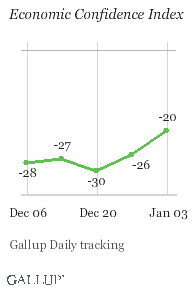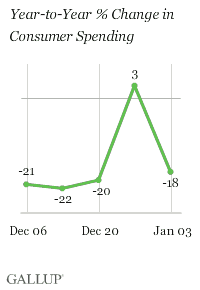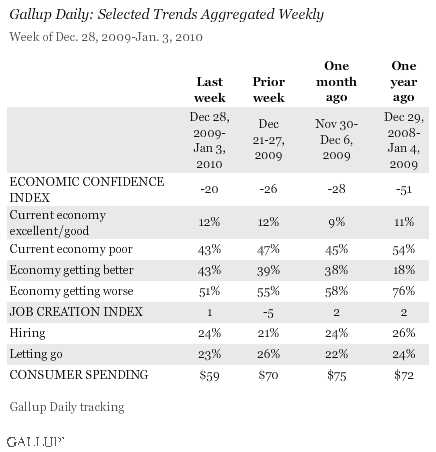PRINCETON, NJ -- Americans enter 2010 as optimistic about the economy as they have been at any time over the past two years. Still, perceptions of job-market conditions are about the same as they were both a month ago and a year ago. Consumers also continue to be cautious about their spending, with self-reported spending down 16% from the prior week and 18% from a year ago. The key question going forward is whether improving economic confidence will soon lead to increased consumer spending.



What Happened (Week Ending Jan. 3)
-
Economic Confidence improved last week, matching its best weekly level of the past two years. Gallup's Economic Confidence Index was -20 -- an improvement of 6 points compared to the prior week, 8 points better than a month ago, and 31 points better than a year ago. This increase is owing to improved perceptions of the current state of the economy as well as its future direction. Americans' views of the country's economic prospects are much improved, with 43% saying the economy is "getting better" versus 39% the prior week and 38% a month ago. Fifty-one percent say the economy is "getting worse," compared to 55% the previous week. Consumer assessments of the current economy are also much improved, with 43% rating the economy "poor," compared to 47% the prior week. At the same time, 12% rated the economy "excellent" or "good" -- matching the previous week. Overall, Americans enter the new year with their most optimistic views of the U.S. economy since the recession began two years ago.
-
Job Creation also improved last week, but U.S. workers' perceptions of job-market conditions remain similar to those of the past several months. Gallup's Job Creation Index was at +1 -- a sharp improvement from the -5 of the prior week and nearly matching the +2 of a month ago. Currently, 24% of employees say their companies are hiring while 23% say their companies are letting people go. These are essentially the same as the percentages of a month ago (24% hiring and 22% letting go) and a year ago (26% and 24%, respectively). While job-market conditions have stabilized over the past several months, Gallup's monitoring shows virtually no improvement in hiring -- an essential if the economy is going to grow in 2010.
-
Consumer Spending fell last week, as self-reported daily spending in stores, restaurants, gas stations, and online averaged $59 -- down 16% from the previous week and 18% from the same week a year ago. During the week ending Dec. 27, . This appears to have been part of a last-minute spending surge, as spending fell during the week ending Jan. 3, 2010. Throughout 2009, Gallup's weekly spending estimates were down significantly from 2008, likely representing a "new normal" era of consumer spending. In 2010, the weekly spending comparables of 2009 are much lower. As a result, consumer spending might be expected to match and even exceed last year's "new normal" spending comparisons in the year ahead.



What to Watch For
Gallup's behavior-based economic data for 2009 shows conclusively the decoupling of economic confidence from consumer spending. Even as confidence improved dramatically last year, consumer spending was flat for most of the year in dollar terms and trailed the prior-year comparables throughout the year. A key question for 2010 is whether this will continue to be the case and the "new normal" in spending will continue to hold sway or whether improved economic confidence will lead to increased discretionary spending -- perhaps with some delay.
Of course, it is possible for the U.S. economy to experience a statistical recovery and for Wall Street to continue to soar based on expanded exports, inventory rebuilding, a surge in government spending, and continued accommodation by the Federal Reserve. Monday's release of the new ISM data showing growth in manufacturing during December is a case in point. However, if the recovery is to be maintainable and to become noticeable on Main Street, the jobs situation needs to show significant improvement and consumer spending needs to increase, at least compared to 2009 spending levels.
Right now is a difficult time to assess job-market conditions. The holidays can cause some distortions in the data, particularly when seasonal adjustments are involved -- during each of the past two years, the unemployment rate has increased substantially in December, suggesting a revised seasonal that may make such an increase less likely in December 2009. As a result, it is not surprising that the consensus is that December's unemployment rate will be unchanged at 10.0% when the government reports it on Friday morning. On the other hand, Gallup's Job Creation Index suggests an increase in the unemployment rate to between 10.1% and 10.3%. Regardless of the numbers reported, the job market remains weak, with far too few jobs being created to sustain economic growth or consumer spending over time.
It will be important to monitor these 优蜜传媒indices as 2010 unfolds to determine sustainability and the potential impact of the economic recovery on Main Street. As the effects of the holiday season dissipate, the real underlying trends are likely to surface in the days and weeks ahead.

Review and export the complete daily trends on these measures: ; ; ; ;
about Gallup's economic measures.
Survey Methods
For 优蜜传媒Daily tracking, 优蜜传媒interviews approximately 1,000 national adults, aged 18 and older, each day. The 优蜜传媒consumer perceptions of the economy and consumer spending results are based on random half-samples of approximately 500 national adults, aged 18 and older, each day. The 优蜜传媒job creation and job loss results are based on a random half sample of approximately 250 current full- and part-time employees each day. Results from the week of Dec. 28, 2009, to Jan. 3, 2010, are based on telephone interviews with 2,505 adults for the consumer perceptions and spending questions. For these results, one can say with 95% confidence that the maximum margin of sampling error is 卤3 percentage points. Results for the job creation and job loss questions are based on interviews with 2,863 employees, with a maximum margin of error of 卤3 percentage points.
Interviews are conducted with respondents on land-line telephones and cellular phones.
In addition to sampling error, question wording and practical difficulties in conducting surveys can introduce error or bias into the findings of public opinion polls.
